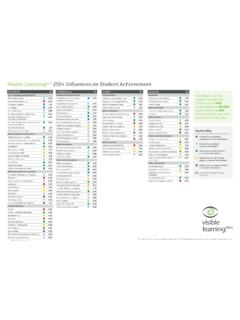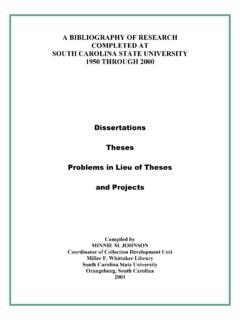Transcription of Relationships Between Problem Behaviors and Academic ...
1 06. barriga, pp. 233-240 10/24/02 3:59 PM Page 233. Relationships Between Problem Behaviors and Academic achievement in Adolescents: The Unique Role of Attention Problems ALVARO Q. BARRIGA, JEFFREY W. DORAN, STEPHANIE B. NEWELL, ELIZABETH M. MORRISON, VICTOR BARBETTI, AND BRENT DEAN ROBBINS. A. SUBSTANTIAL BODY OF RESEARCH Numerous studies have documented Relationships Between a variety of Problem Behaviors and Academic has documented associations be- achievement measures. However, the results of these studies should be interpreted cautiously, given the tween Problem Behaviors and aca- considerable comorbidity of Problem Behaviors that often exists among school-age study ad- demic achievement .
2 This topic has rele- dressed the Relationships Between 8 teacher-reported Problem behavior syndromes (withdrawal, somatic vance from an educational perspective that complaints, anxiety/depression, social problems, thought problems, attention problems, delinquent behav- views Problem Behaviors as serious im- ior, aggressive behavior ) and standardized measures of Academic achievement (overall, reading, spelling, pediments to optimal education. From a arithmetic, performance). The sample comprised 41 boys and 17 girls ages 11 to 19 years (M = , psychopathology perspective, low aca- SD = ) enrolled in an alternative school. Although withdrawn, somatic complaints, delinquent behav- demic achievement represents a signifi- ior, and aggressive behavior syndromes exhibited significant zero-order correlations with the Academic cant risk factor for poor behavioral out- achievement measures, each of these Relationships was mediated by attention problems.
3 A post hoc analy- comes. A systemic viewpoint posits that sis suggested that the observed association Between attention problems and Academic achievement was behavioral and Academic problems exert primarily due to the inattention component of the syndrome rather than the hyperactivity impulsivity reciprocal influences on one another, findings are discussed with reference to theoretical, research, and treatment implications. which, over time, can negatively affect the development of individuals and their en- vironments. Regardless of perspective, a level rather than discrepant from one's Additionally, the symptoms of attention- clear understanding of the relationship be- general cognitive ability (as in the diag- deficit/hyperactivity disorder have shown tween Problem Behaviors and Academic nosis of learning disabilities).
4 A wide va- a robust inverse relationship with achieve- achievement will help generate appropri- riety of Problem Behaviors have been ment (Faraone et al., 1993). Problem be- ate assessment, prevention, and interven- linked to Academic underachievement. haviors associated with internalizing have tion strategies for at-risk or troubled For example, investigations have consis- also evidenced connections to Academic youth. tently revealed that aggression and other underachievement, though less consis- We are using the term Academic un- forms of antisocial behavior display in- tently. Anxiety and negativism have been derachievement to denote Academic per- verse Relationships with Academic achieve- identified as key personality traits associ- formance that is below normative age ment ( , Williams & McGee, 1994).
5 Ated with Academic problems (Stevens &. JOURNAL OF EMOTIONAL AND B E H AV I O R A L DISORDERS, WINTER 2002, VOL. 10, NO. 4, PAG E S 233 240 233. 06. barriga, pp. 233-240 10/24/02 3:59 PM Page 234. Pihl, 1987). Moreover, several researchers izing disorders even include symptoms student, the attending psychologist at the have linked depressive disorders or symp- that explicitly refer to attention difficul- school approximated that 70% of these toms to underachievement ( , Puig- ties ( , difficulty concentrating is a children were identified with severe emo- Antich et al., 1993). It is noteworthy that symptom of major depressive disorder, tional disturbance, and their IQs were gen- other researchers have found no connec- generalized anxiety disorder, and post- erally in the low average and borderline tions Between internalizing symptoms traumatic stress disorder).
6 Intellectual functioning ranges. The par- and poor Academic performance ( , Attention problems may represent a ticipants were 55% Caucasian and 45%. Reinherz et al., 1993). At this time, the ev- syndrome that is not only comorbid with, African American. idence regarding this relationship remains and conceptually related to, a variety of equivocal. In addition to externalizing and other syndromes but also fundamentally Measures internalizing symptoms, quality of social involved in Academic underachievement. relations has been linked to Academic Attention deficiencies could represent Teacher's Report Form for Ages 5 to achievement and related variables.
7 A sub- core elements of poor Academic function- 18 (TRF; Achenbach, 1991b). The TRF. jective sense of belonging and interper- ing that can coexist with a variety of other is a multidimensional behavior rating sonal support has been associated with Problem Behaviors that do not necessarily scale designed to appraise youths' aca- higher achievement motivation and edu- have a direct impact on Academic achieve- demic and adaptive functioning as well as cational plans (Cotterell, 1992; Goode- ment. To evaluate this hypothesis, the their Problem Behaviors . The Academic now, 1993). Conversely, peer rejection has Relationships Between eight teacher- Performance scale, which assesses teach- been found to be a risk factor for Academic reported Problem behavior syndromes ers' perceptions of students' Academic underachievement ( , Ollendick,Weist, (withdrawal, somatic complaints, anxiety/ work across several subjects relative to Borden, & Greene, 1992).)
8 Depression, social problems, thought grade level, was used as a teacher-reported Interpretation of this research should problems, attention problems, delinquent measure of Academic achievement . The proceed cautiously. Research of Problem behavior , aggressive behavior ) and stan- eight Problem scales (Withdrawal, So- Behaviors is complicated by the fact that dardized measures of Academic achieve- matic Complaints, Anxiety/Depression, many children and adolescents exhibit ment (overall, reading, spelling, arith- Social Problems, Thought Problems, At- multiple Problem Behaviors . Significant metic, performance) were assessed. Our tention Problems, Delinquent behavior , comorbidity among a substantial propor- primary aim was to determine whether or and Aggressive behavior ) were used to tion of youths has been documented in not attention problems mediate the rela- represent the various Problem Behaviors referred and nonreferred samples ( , tionships Between other Problem behav- of interest in the present study.
9 Achenbach McConaughy & Achenbach, 1994). In- iors and Academic underachievement. A (1991a) reported extensive favorable reli- vestigators should be aware of potential secondary aim was to explore possible ability (test retest, internal consistency, confounds that can result from associated curvilinear and moderated Relationships interrater) and validity (content, con- Problem Behaviors that are not of primary Between these sets of variables. vergent, divergent, discriminant, factor- interest in a particular study. Specifically, analytic) findings for the TRF. in the present study, a Problem behavior Because we investigated the TRF prob- may exhibit a spurious correlation with METHOD lem scales in relation to Academic achieve- Academic achievement only because it is ment measures, we eliminated four TRF.
10 Participants associated with another Problem behavior Problem items that were judged to be that plays a more direct or central role in Participants were 41 boys and 17 girls confounded with Academic achievement : Academic achievement . Studies of exter- ages 11 to 19 years (M = , SD = ) Has difficulty learning, Poor school nalizing problems have suggested that enrolled in an alternative school that work, Messy work, and Underachiev- aggressive Behaviors in childhood are re- served a predominantly urban area of a ing, not working up to potential. Re- lated to underachievement primarily be- large eastern city. Students were referred moving these items was necessary to cause of their associations with attention to the alternative school by school ad- avoid a tautologous comparison ( , cri- problems ( , Frick et al.))







